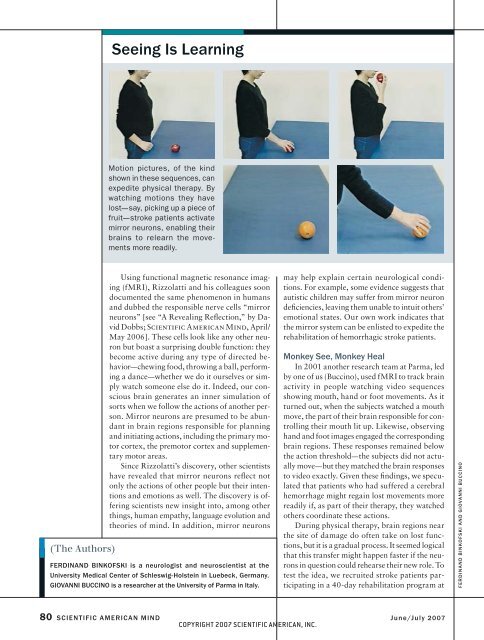Scientific American Mind-June/July 2007
Scientific American Mind-June/July 2007
Scientific American Mind-June/July 2007
You also want an ePaper? Increase the reach of your titles
YUMPU automatically turns print PDFs into web optimized ePapers that Google loves.
(The Authors)<br />
Seeing Is Learning<br />
Motion pictures, of the kind<br />
shown in these sequences, can<br />
expedite physical therapy. By<br />
watching motions they have<br />
lost—say, picking up a piece of<br />
fruit—stroke patients activate<br />
mirror neurons, enabling their<br />
brains to relearn the movements<br />
more readily.<br />
Using functional magnetic resonance imaging<br />
(fMRI), Rizzolatti and his colleagues soon<br />
documented the same phenomenon in humans<br />
and dubbed the responsible nerve cells “mirror<br />
neurons” [see “A Revealing Refl ection,” by David<br />
Dobbs; Scientifi c <strong>American</strong> <strong>Mind</strong>, April/<br />
May 2006]. These cells look like any other neuron<br />
but boast a surprising double function: they<br />
become active during any type of directed behavior—chewing<br />
food, throwing a ball, performing<br />
a dance—whether we do it ourselves or simply<br />
watch someone else do it. Indeed, our conscious<br />
brain generates an inner simulation of<br />
sorts when we follow the actions of another person.<br />
Mirror neurons are presumed to be abundant<br />
in brain regions responsible for planning<br />
and initiating actions, including the primary motor<br />
cortex, the premotor cortex and supplementary<br />
motor areas.<br />
Since Rizzolatti’s discovery, other scientists<br />
have revealed that mirror neurons refl ect not<br />
only the actions of other people but their intentions<br />
and emotions as well. The discovery is offering<br />
scientists new insight into, among other<br />
things, human empathy, language evolution and<br />
theories of mind. In addition, mirror neurons<br />
FERDINAND BINKOFSKI is a neurologist and neuroscientist at the<br />
University Medical Center of Schleswig-Holstein in Luebeck, Germany.<br />
GIOVANNI BUCCINO is a researcher at the University of Parma in Italy.<br />
may help explain certain neurological conditions.<br />
For example, some evidence suggests that<br />
autistic children may suffer from mirror neuron<br />
defi ciencies, leaving them unable to intuit others’<br />
emotional states. Our own work indicates that<br />
the mirror system can be enlisted to expedite the<br />
rehabilitation of hemorrhagic stroke patients.<br />
Monkey See, Monkey Heal<br />
In 2001 another research team at Parma, led<br />
by one of us (Buccino), used fMRI to track brain<br />
activity in people watching video sequences<br />
showing mouth, hand or foot movements. As it<br />
turned out, when the subjects watched a mouth<br />
move, the part of their brain responsible for controlling<br />
their mouth lit up. Likewise, observing<br />
hand and foot images engaged the corresponding<br />
brain regions. These responses remained below<br />
the action threshold—the subjects did not actually<br />
move—but they matched the brain responses<br />
to video exactly. Given these fi ndings, we speculated<br />
that patients who had suffered a cerebral<br />
hemorrhage might regain lost movements more<br />
readily if, as part of their therapy, they watched<br />
others coordinate these actions.<br />
During physical therapy, brain regions near<br />
the site of damage do often take on lost functions,<br />
but it is a gradual process. It seemed logical<br />
that this transfer might happen faster if the neurons<br />
in question could rehearse their new role. To<br />
test the idea, we recruited stroke patients participating<br />
in a 40-day rehabilitation program at<br />
80 SCIENTIFIC AMERICAN MIND <strong>June</strong>/<strong>July</strong> <strong>2007</strong><br />
COPYRIGHT <strong>2007</strong> SCIENTIFIC AMERICAN, INC.<br />
FERDINAND BINKOFSKI AND GIOVANNI BUCCINO

















